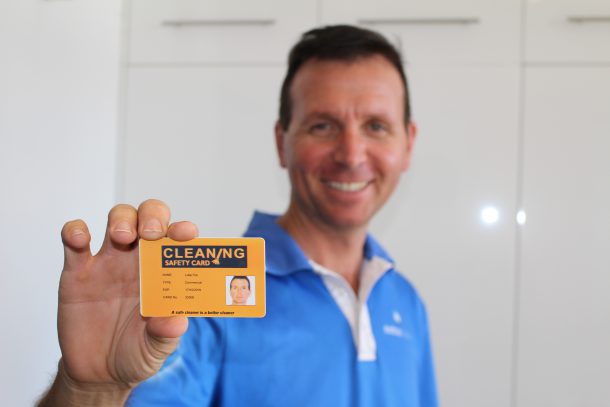
Launched in October 2017, the Cleaning Safety Card is an online training program designed to reduce the rate of workplace injuries in the cleaning industry. Cleaning Safety Card director Luke Fox tells INCLEAN assistant editor Lizzie Hunter of his plans for the program to gain industry-wide recognition.
The Cleaning Safety Card is the brainchild of Luke Fox whose family has been in the cleaning business for 40 years, following research conducted by Fox on workplace injury rates.
According to Safe Work Australia, the cleaning industry has the second highest rate of workplace injury claims. Over five years to 2015-16, the average frequency rate of serious claims for the building cleaning, pest control and gardening services industry was 12.6 serious claims per million hours worked; almost double the all industries rate (6.4 serious claims per million hours worked).
The safety training program is available for both domestic and commercial cleaners, and includes topics such as exploring fire exits, using a colour coded system for cleaning, optimum vacuuming and mopping techniques, safe use of chemicals and electrical cords, warm up stretches and risk assessment to reduce injury.
“When I first heard that statistic I almost fell off my chair! I thought to myself, something’s got to be done. We can’t just keep going on doing the same old thing and achieving the same old results.”
The program consists of seven modules which Fox says can be completed in one to two hours. A 12 month Safety Card accreditation costs $44, while a two-year accreditation is $66.
“Safety rules are always changing; there is always something new coming into play,” said Fox. “That’s why we’re looking to add new courses and create new versions of the Cleaning Safety Card.”
Fox’s ultimate goal for the online training program is for it to receive widespread industry recognition within the next two years, having already received initial endorsement by the Australian Cleaning Contractors’ Alliance.
He is hoping to set up talks with government and local industry associations to get the program formally recognised and adopted across the country.
“I want the card to be mandatory for everyone who wants to be a cleaner,” he said. “If you want a job serving alcohol, you need an RSA licence. If you work in the construction industry, you need a White Card. If you work with children, you need a Working with Children Check. My goal is that one day, a requirement for those working in the cleaning industry, will be the orange Cleaning Safety Card.”
Fox says the Cleaning Safety Card has been well received by the industry so far and is starting to gain traction among contractors.
“A lot of the bigger cleaning companies have said that the industry has needed this [the Cleaning Safety Card] for a long time.
[quote]“In the cleaning industry today, the onus is now on proving you are what you say you are. It’s no longer a case of ‘take our word for it’ or ‘the results speak for themselves’. A lot of customers and government agencies now want cleaners to prove cleaners are on site and how long they were there. [/quote]
“The Cleaning Safety Card provides proof a cleaner has a basic understanding of industry best practices by undertaking a workplace health and safety induction. Cleaners who possess a Cleaning Safety Card will be able to improve their employability and show photo identification, which recognises their knowledge and skillset.”
Australian Cleaning Contractors’ Alliance executive director, John Laws, has welcomed the initiative, saying standardised guidelines for safe work practice in the industry were overdue.
“The cleaning industry represents 2.5 per cent of the workforce, yet there’s no national framework in place. Every cleaner, every cleaning business, is playing by their own rules,” said Laws.
Fox says one of the most eye-opening experiences when creating the Cleaning Safety Card was the fact the majority of cleaners he interviewed were unaware of proper workplace health and safety practices.
“We conducted interviews to gauge the cleaners’ understanding of basic safety. All of their answers were different and not many could provide the right answer. That’s when I knew there had to be an industry standard or benchmark for safety in the cleaning industry.”
“It’s appalling that our industry has one of the highest rates of injuries. I want to see the number of falls, trips and slips reduced by at least half by 2020 through a comprehensive program that trains cleaners in industry best practice.”
This first appeared in the January/February issue of INCLEAN magazine. To subscribe, click here.